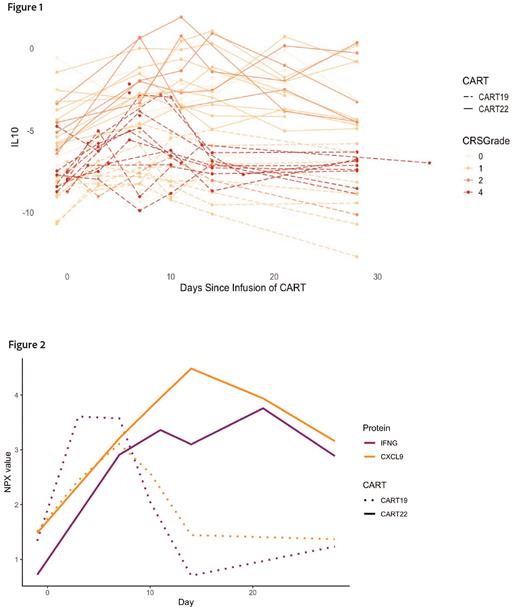Introduction: CD19-directed CART (CART19) are highly effective in the treatment of relapsed or refractory B-cell acute lymphoblastic leukemia (B-ALL). However, some pts relapse with CD19 negative disease after CART19, which has led to the development of CD22-directed CART (CART22). While CART22 has produced 70% CR in CD19 negative ALL, this is lower than CART19 and there is less evidence for long-term disease control compared to CART19. Interestingly, toxicity patterns are different with CART22 pts experiencing a later and less severe CRS even at high disease burden. To better understand these differences in efficacy and toxicity we conducted comprehensive serum proteomic profiling on serial samples from pts treated with CART-19 or -22.
Methods: Serial serum samples from pts enrolled on two clinical trials of the murine CART19 CTL019 (NCT01626495 & NCT02906371) and CART22 (NCT02650414) were examined. Pts were categorized as having severe (Grade 3 or 4) or minimal CRS (Grade 1 or 2).
All statistical analyses were performed using R (v4.2.2) and PRISM (v9). Differential expression analyses were performed between CART19 and CART22 pts. Significance was defined as an absolute fold change > 2, and a false discovery rate (FDR) < 0.05. All in vitro experiments were performed in triplicate. Two-tailed t tests were calculated.
Results: 43 pts (CART19 N=26 and CART22 N=17) with 223 unique timepoints were included in this analysis. All CART22 pts had minimal CRS; 13 CART19 pts had minimal and 13 had severe CRS. Both cohorts had high disease burden prior to infusion (CART19 mean = 29.9%, CART22 mean=44.3%, p=0.19). All pts who received CART22 had previously received CD19 directed immunotherapy (CART19 N=16, blinatumomab N=1).
At the pre-infusion timepoint, 12 proteins were significantly different between pts in the CART19 and CART22 cohorts. The protein most significantly differentially expressed in patients who subsequently underwent CART22 treatment was the anti-inflammatory cytokine IL-10. IL-10 levels were consistently elevated in patients who received CART22, surpassing levels at all observed timepoints, even when compared with patients treated with CART19 who developed severe CRS (See Fig 1). We therefore hypothesized the IL-10 levels may be impacting the efficacy and CRS associated with CART22.
We next tested the impact of IL-10 on IFNγ as a surrogate marker of CRS in a series of in vitro experiments. CART-19 or -22 cells from the same donor were co-cultured with NALM-6 cells in the presence and absence of IL-10. Without IL-10 present, CART22 cells produced higher levels of IFNγ than CART19 cells (8959 vs 6395 pg/mL, p=0.005). Inversely, with IL-10 present, CART19 cells produced more IFNγ than CART22 cells (21006 vs 15157 pg/mL, p=0.05). We evaluated the length of immune synapse (IS) formation, the time between CART cell interaction and blast killing, using live-cell microscopy, and found that CART22 cells had a trend towards a prolonged IS formation relative to CART19 cells (median time to detachment 9.1 min vs. 3.5 min, p=ns).
Finally, given the differences in time of onset of CRS following CART19 vs CART22, we looked at levels of IFNγ and its canonical responder CXCL9 between pts with minimal CRS only. As expected, we found a later peak of IFNγ in CART22 pts compared to CART19 pts (Figure 2). Interestingly, despite similar peaks in IFNγ, CXCL9 levels were higher in CART22 pts, implying dysregulation of the IFNγ/CXCL9 axes in CART22 but not CART19 pts.
Conclusions: Comparing comprehensive serum proteomic profiling between CART19 and CART22 pts we make several novel observations. First, IL-10 levels are significantly higher in CART22 pts at pre-infusion, suggesting that previous immunotherapy has caused an upregulation of this anti-inflammatory cytokine. Second, we show that IL-10 levels have a differential impact on IFNγ levels in CART19 vs CART22 cells. This may impact both CRS associated with CART cells and efficacy and may contribute to observed differences in IFNγ and CXCL9 levels seen between the two patient populations. These findings are significant for the clinical translation of CART22 and other immunotherapies, as previous immunotherapy may lead to sustained alterations in the cytokine milieu. Furthermore, IL-10 is a targetable cytokine that could be modulated in future studies to improve efficacy of CART22.
Disclosures
Behrens:Sobi: Consultancy; Genzyme: Consultancy; AB2Bio: Research Funding. June:Danaher: Membership on an entity's Board of Directors or advisory committees; WIRB-Copernicus: Membership on an entity's Board of Directors or advisory committees; Verismo: Membership on an entity's Board of Directors or advisory committees; Poseida: Membership on an entity's Board of Directors or advisory committees; Decheng: Membership on an entity's Board of Directors or advisory committees; Celldex: Membership on an entity's Board of Directors or advisory committees; Cellares: Membership on an entity's Board of Directors or advisory committees; Cartography: Membership on an entity's Board of Directors or advisory committees; Carisma: Membership on an entity's Board of Directors or advisory committees; Cabaletta: Membership on an entity's Board of Directors or advisory committees; BluesphereBio: Membership on an entity's Board of Directors or advisory committees; AC Immune: Membership on an entity's Board of Directors or advisory committees; Kite Pharma: Consultancy, Membership on an entity's Board of Directors or advisory committees, Research Funding. Canna:Sobi: Other: Paid speaking; Janssen: Other: Paid speaking; PracticePoint communications: Other: Paid speaking; Apollo therapeutics: Consultancy; Simcha therapeutics: Consultancy. Grupp:Jazz: Consultancy, Membership on an entity's Board of Directors or advisory committees, Research Funding; Kite: Research Funding; Vertex: Consultancy, Research Funding; Novartis: Consultancy, Research Funding; Servier: Research Funding; CBMG: Consultancy, Membership on an entity's Board of Directors or advisory committees; Adaptimmune: Consultancy, Membership on an entity's Board of Directors or advisory committees; Cellectis: Consultancy, Membership on an entity's Board of Directors or advisory committees; Juno: Consultancy, Membership on an entity's Board of Directors or advisory committees; Allogene: Consultancy, Membership on an entity's Board of Directors or advisory committees; Cabaletta: Consultancy, Membership on an entity's Board of Directors or advisory committees. Teachey:Neoimmune Tech: Research Funding; BEAM: Research Funding; Sobi: Membership on an entity's Board of Directors or advisory committees, Research Funding; Jazz: Membership on an entity's Board of Directors or advisory committees, Research Funding.


This feature is available to Subscribers Only
Sign In or Create an Account Close Modal